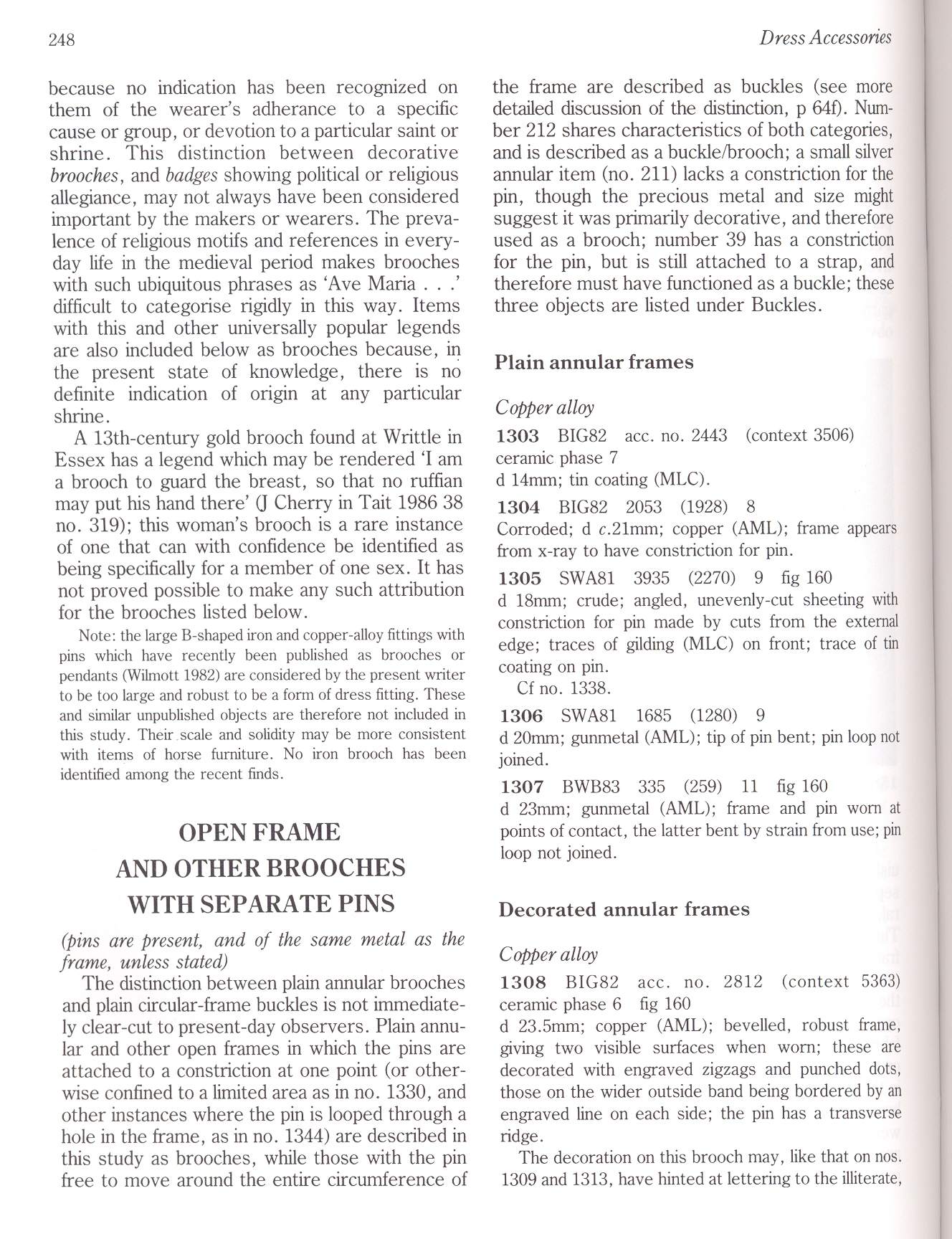276 (40)

248
Dress Accessońes
because no indication has been recognized on them of the wearer’s adherance to a specific cause or group, or devotion to a particular saint or shrine. This distinction between decorative brooches, and badges showing political or religious allegiance, may not always have been considered important by the makers or wearers. The preva-lence of religious motifs and references in every-day life in the medieval period makes brooches with such ubiąuitous phrases as ‘Ave Maria . . difficult to categorise rigidly in this way. Items with this and other universally popular legends are also included below as brooches because, in the present State of knowledge, there is no definite indication of origin at any particular shrine.
A 13th-century gold brooch found at Writtle in Essex has a legend which may be rendered ‘I am a brooch to guard the breast, so that no ruffian may put his hand there’ 0 Cherry in Tait 1986 38 no. 319); this woman’s brooch is a rare instance of one that can with confidence be identified as being specifically for a member of one sex. It has not proved possible to make any such attribution for the brooches listed below.
Notę: the large B-shaped iron and copper-alloy fittings with pins which have recently been published as brooches or pendants (Wilmott 1982) are considered by the present writer to be too large and robust to be a form of dress fitting. These and similar unpublished objects are therefore not included in this study. Their scalę and solidity may be morę consistent with items of horse fumiture. No iron brooch has been identified among the recent finds.
OPEN FRAME
AND OTHER BROOCHES
WITH SEPARATE PINS
(pins are present, and of the same metal as the frame, unless stated)
The distinction between plain annular brooches and plain circular-frame buckles is not immediate-ly clear-cut to present-day observers. Plain annular and other open frames in which the pins are attached to a constriction at one point (or other-wise confined to a limited area as in no. 1330, and other instances where the pin is looped through a hole in the frame, as in no. 1344) are described in this study as brooches, while those with the pin free to move around the entire circumference of the frame are described as buckles (see morę detailed discussion of the distinction, p 64f). Num-ber 212 shares characteristics of both categories, and is described as a buckle/brooch; a smali silver annular item (no. 211) lacks a constriction for the pin, though the precious metal and size might suggest it was primarily decorative, and therefore used as a brooch; number 39 has a constriction for the pin, but is still attached to a strap, and therefore must have functioned as a buckie; these three objects are listed under Buckles.
Plain annular frames
Copper alloy
1303 BIG82 acc. no. 2443 (context 3506) ceramic phase 7
d 14mm; tin coating (MLC).
1304 BIG82 2053 (1928) 8
Corroded; d c.21mm; copper (AML); frame appears from x-ray to have constriction for pin.
1305 SWA81 3935 (2270) 9 fig 160
d 18mm; crude; angled, unevenly-cut sheeting with constriction for pin madę by cuts from the extemal edge; traces of gilding (MLC) on front; tracę of tin coating on pin.
Cf no. 1338.
1306 SWA81 1685 (1280) 9
d 20mm; gunmetal (AML); tip of pin bent; pin loop not joined.
1307 BWB83 335 (259) 11 fig 160
d 23mm; gunmetal (AML); frame and pin wom at points of contact, the latter bent by strain from use; pin loop not joined.
Decorated annular frames
Copper alloy
1308 BIG82 acc. no. 2812 (context 5363)
ceramic phase 6 fig 160
d 23.5mm; copper (AML); bevelled, robust frame, giving two visible surfaces when wom; these are decorated with engraved zigzags and punched dots, those on the wider outside band being bordered by an engraved linę on each side; the pin has a transverse ridge.
The decoration on this brooch may, like that on nos.
1309 and 1313, have hinted at lettering to the illiterate,
Wyszukiwarka
Podobne podstrony:
278 (40) 250 Dress Accessories 1314 1311 SWA81 2186 (2055) 9 fig 160 Corroded
251 (40) 222 Dress Accessories and also one wom on the right on a lady’s effigy from Normandy (fig 1
413 (9) 386 Dress Accessories lining, which was presumably glued into place, so that the lining proj
Sr. No. Module* / tnits 1 COMPANY ACCOUNTS (Including provisions of Companies Act rclcvant to thc s
pg074 Rxh.njRuched mini dress and sleeves Modol tho linmg sections and leave them pmned bu! un-sewn
70195 mbs 102 MY BREATHING SYSTEM EXERCISE No. 9. Special abdominal breathing, combined with movemen
PROBLEMS OF INFORMATION TRANSMISSION Vol. III, No. 4, 1967 - USSR - Following is a complete translat
IQ /; 3 o v 1 e t M o n 1 t o r No. 4402. March,19th 1944• *23 OFFICSRS OF THE POLISH A HET PRDMOTED
BUW 1 (276) [1024x768] dcmencję, można przeczytać w artykułach Alana Crbasa I łn Serotemm Receptor C
284 (41) 256 Dress Accessońes Hooked annular brooch Copper alloy 1338 SWA81 acc. no. 1493 (context
304 (37) 276 Dress Accessońes slightly damaged (an impressed dot here may not be an original feature
341 (27) 314 Dress Accessońes site acc. no. context ceramic hole diameter number
343 (24) 316 Dress AccessońesTIN 1584 SWA81 acc. no. 2788 (context 2108) cera
419 (10) 392 Dress Accessories cases, though it is likely to have been present. Brass mount no. 935
257 (39) 228 1218 i 1222 Dress Accessories 142 Eyelets(lrl) In same finds bag was acc. no. 801E - pa
264 (42) 236 Dress Accessońes are fiat (no morę than 0.5mm thick) and are in the form of a disc with
498 Because there is no homogenous definition of risk in Insurance Theory, the first part of the art
więcej podobnych podstron